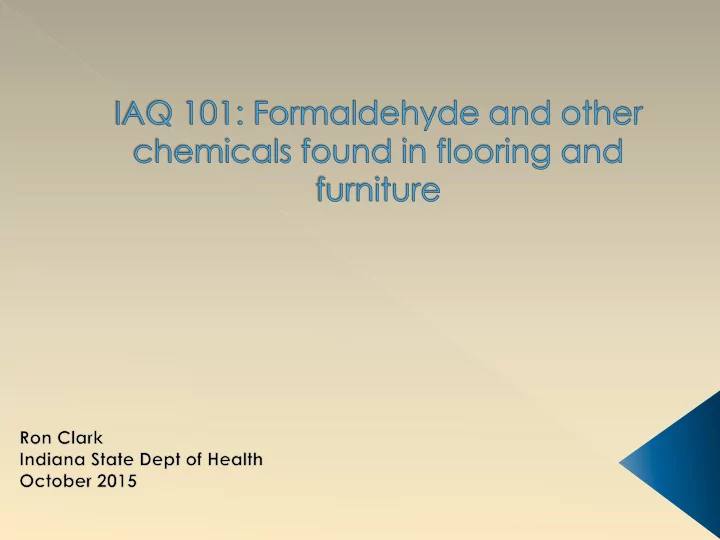

EPA states indoor air is 5 to 100 times more polluted than the outdoor air The average person spends 80% of their time indoors. 20 million in US have Asthma, including 1 in 7 children. We don’t have a count of the number with allergies to indoor pollutants
For homes there are no regulations for indoor air quality, only guidelines IC 16-41-37.5 Instructs ISDH to inspect any school (k-12) or state government building when we get a complaint of IAQ No IAQ regulations for childcare, kindergartens, or universities.
Biological – Insects, dust mites, pets, mold, plants , foods (peanuts) Particulates – dust, soot(heaters, candles), cooking, smoking Chemical – Smoking, cleaners, fragrances, pesticides, hobbies/crafts, paints, garage?? Chemical – building materials and furnishings
Why is it there and were else is it found CARB (Cal. Air Resource Board) emission standard TV 60 Minutes report
o EPA – symptoms starting at 0.100 ppm o CARB – recommends 0.030 ppm o Workplace • NIOSH 0.016 ppm • OSHA 0.75 ppm for 8 hr workday, 0.5 ppm action level
At very low concentrations no adverse health effects Low concentrations irritation to respiratory tract, eyes, and skin Higher concentration / long term exposure may cause some types of cancer. EPA – probable carcinogen ATSDR: Nasal and eye irritation, neurological effects, and increased risk of asthma and/or allergy have been observed in humans breathing 0.1 to 0.5 ppm. Eczema and changes in lung function have been observed at 0.6 to 1.9 ppm.
Carpet – styrene and 4-phenylcyclohexene Plastics – Phthalates: banned in children’s toys still in some vinyl flooring VOC’s – paints, varnishes, adhesives EPA – significant evidence causes sensory irritation, may cause headache, fatigue SVOC’s – small fraction as a gas but persistent in the environment : pesticides, plasticizers, flame retardants
Bromated and chlorinated compounds with growing concern about health effects Not chemically bound but incorporated › May leach out to be ingested or inhaled with dust particles California TB-117 required FR in foam cushions – default national standard – recently changed
Green Certified , MAS Certified Green › 3rd party, low VOC emitting products Green Seal – 3 rd party EcoLogo – was Canadian government but now part of Underwriter’s Laboratory LEED – Leadership in Energy and Environmental Design, entire building
CARB – California Air Resource Board – several rules like for formaldehyde Greener Choices – Consumer Reports Greenerchoices.org/eco-labels/ › Able to search through green certifications for all kinds of products – tells you what the certification means.
Ron Clark Indoor Air Section, Environmental Health Div. Indiana State Dept. of Health 2525 N Shadeland Ave., E3 Indianapolis IN 46219 317.351.7190 x 234 RDClark@isdh.IN.gov
Recommend
More recommend